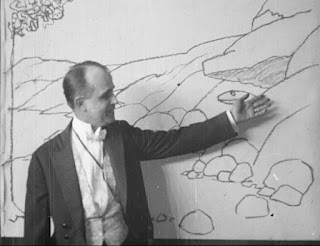Please join the Chicago Film Seminar on November 16 at 7:30 PM for our annual graduate student panel, featuring talks by Ilana Emmett (Northwestern University) and Mikki Kressbach (University of Chicago). James Lastra (University of Chicago) will serve as respondent.
The Graduate Student Panel will be held at DePaul’s Loop Campus in the Daley Building at 14 E. Jackson Blvd., Room LL 102 (use the State Street entrance located at 247 S. State).
A reception will follow the panel.
See below for more information on the talks and presenters.
Sound and Silence: Conversation, Emotion, and the Creation of Domestic Spaces on American Radio Soap Operas
by Ilana Emmett
From their earliest days on radio, American daytime serials have been associated with their domestic settings. But how exactly did this notion develop within a medium that has no physical location and takes up no space? And what did this aesthetic of domesticity afford or deny for its supposed female listeners? By considering the role of sound early in this popular genre, I interrogate what the aesthetic space of soap operas allowed for, even as its fast-paced production schedule may have, in fact, prevented more complex sound design. The combination of dialogue, narration, simple everyday sound effects, and often not much else meant that the invisible spaces of radio serials created, and then relied on, a sound and a space that was domestic, familial, and emotional. This paper will focus in particular on the role of both silence and voiceover narration in allowing listeners to place uncanny versions of themselves within the narrative. Through its soundscape, radio serials created domestic spaces where there were none and began daytime soap opera’s ongoing commitment to emotional production and complex aesthetics.
Ilana Emmett is a PhD candidate at Northwestern University. She is currently working on her dissertation, which focuses on the aesthetics of American daytime soap operas on radio and television from 1930 to today. Additional research addresses the history of television programming for deaf audiences in the U.S. and the U.K. She has a B.A. in Cinema and Media Studies from the University of Chicago and an M.A. in Film and Television Studies from the University of Warwick in the U.K.
Does Data Determine Our Situation?: Wearable Fitness Tracking Technologies and Quantifying the Everyday
by Mikki Kressbach
Wearable technologies (e.g., Fitbit and Apple Watch) and fitness tracking apps (e.g., Today, Record, and Human) allow individuals to passively monitor their vital signs, movements, and exercises in pursuit of health and wellness. For users, self-improvement depends on a direct relationship between data and self-knowledge. In an effort to explore the impacts of these devices and apps, this talk asks: how do wearable fitness tracking devices and apps shape ordinary interactions and movements through the world? How does the interface design, feedback, and competition features mediate one’s everyday behaviors or condition habits? How does this “datafied” vision of yourself impact one’s sense of success or failure? And how might these features and experiences shape contemporary perceptions of health and wellness? Through phenomenological readings of the device interfaces and features, drawing on my own experience using Apple Watch and Fitbit, as well as student reflections on using mobile tracking apps and self-quantification technologies, I begin to explore these questions by turning to individual experiences and encounters. Recent work on wearable technologies has emphasized the way they participate in the neoliberal collapse of work and leisure by turning daily life into data, ostensibly homogenizing movements, activities, and individuals. I seek to complicate these determinist readings by turning to the disruptions, oddities, and play found in the ordinary encounters with fitness tracking devices and apps.
Mikki Kressbach is a PhD Candidate in the Department of Cinema and Media Studies at the University of Chicago, where she has recently completed her dissertation on the representation of emergent infectious disease in contemporary film, television, and video games. Her work, more broadly, explores the intersection of digital media and paradigms of scientific evidence and logic in contemporary popular culture. This research has led to related projects on the horror genre, health and wellness, and educational video games.
James Lastra is Associate Professor in the Department of Cinema and Media Studies, the Department of English Languages and Literature, and the College at the University of Chicago. He specializes in American film and has published extensively on sound in film, especially as it relates to the unfolding history of modernity and the aesthetics of both high and vernacular modernism. He is the author of Sound Technologies and the American Cinema: Perception, Representation, Modernity (Columbia University Press, 2000), and in addition to his work on sound he has also written on topics including Surrealism, silent film comedy, and the work of Luis Buñuel.




